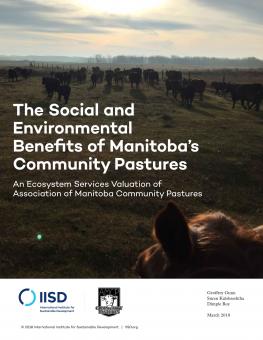
The Social and Environmental Benefits of Manitoba's Community Pastures
A total economic value analysis of Manitoba's community pastures, demonstrating the private and public benefits of sustainable grazing management.
This study summarizes the benefits and related economic values of community pastures managed by the Association of Manitoba Community Pastures in Manitoba, Canada.
Based on data and information directly from the community pastures and information available through a search of relevant literature, the total economic value (TEV) of Manitoba community pastures (MCPs) was calculated. Benefits that were not included in the TEV were highlighted as gaps that could be the focus of further research.
Based on available data and information, this research determined that the ecological goods and services from MCPs are valued at CAD 13,349,646 per year (based on a price of CAD 25 per tonne for carbon dioxide). The largest components of this value are forage production and carbon sequestration, but soil formation, biodiversity, recreation and hunting, community development, and timber are also included. Some components—including species at risk, pollination and long-term carbon storage—were excluded due to insufficient data or significant variation across pasture landscapes. This value therefore represents an incomplete estimate of ecological goods and services from the MCPs studied but does incorporate major service contributions.
Based on this research, the author's recommendations include the maintenance of MCPs and the concentrated benefits that they provide producers and society. These large tracts of natural or naturalized land protect habitat, store carbon, and improve water retention and water quality. There are gaps in existing research, data and information that inhibit more precise valuation of community pastures and grasslands in Western Canada. Current grazing management encourages sustainable delivery of commercial and non-commercial value to the landscape. At the same time, enhanced monitoring systems to qualify and quantify the benefits of ecosystem goods and services from pastures should be developed to measure and assess specific public benefits provided by community pastures. Quantification of total value of benefits informs policy and can help sustain community pastures in the future.
Further examination of the relationships between management systems, their impacts and values would also improve our overall understanding of these valuable, but quickly disappearing, landscapes and provide more guidance for adaptive management.
Participating experts
You might also be interested in
WTO Agriculture Negotiations at MC13: What does the lack of outcomes mean for least developed countries and other vulnerable economies?
IISD expert Facundo Calvo analyzes what came out of the WTO's agriculture negotiations at the 13th Ministerial Conference in Abu Dhabi and its implications for least developed countries and other vulnerable economies.
At WTO meet, India will have to balance between protecting local fishers and fishing sector growth
India is likely to advocate for securing the interests of its artisanal fishers while facilitating the growth of the fishing sector at the World Trade Organisation’s 13th Ministerial Conference (MC13) in Abu Dhabi later this month.
What Is the UAE Framework for Global Climate Resilience, and How Can Countries Move It Forward?
With the introduction of the new framework for the Global Goal on Adaptation (GGA), COP 28 marked a milestone for adaptation. We unpack key outputs and set out how countries can move forward by strengthening their national monitoring, evaluation, and learning (MEL) systems.
National State of the Environment Report: Uzbekistan
The National State of the Environment Report (NSoER) is a comprehensive document that provides a snapshot of current environmental trends in Uzbekistan's socio-economic development for citizens, experts, and policy-makers in the country of Uzbekistan.